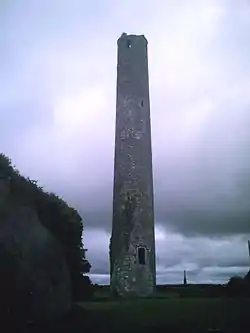Grangefertagh
Grangefertagh is a former abbey located in County Kilkenny, Ireland. It is today a National Monument.
Gráinseach na Fearta Fearta-Caerach | |
 Round tower | |
 Location within Ireland | |
| Monastery information | |
|---|---|
| Other names | Fertagh |
| Order | Canons Regular of Saint Augustine |
| Established | early 6th century |
| Disestablished | 1536 |
| Diocese | Ossory |
| People | |
| Founder(s) | Ciarán of Saigir |
| Architecture | |
| Functional status | In ruins |
| Style | Celtic monastic |
| Site | |
| Location | Grangefertagh, Johnstown, County Kilkenny, Ireland |
| Coordinates | 52.778459°N 7.544599°W |
| Public access | yes |
| Official name | Grangefertagh Round Tower and Church |
| Reference no. | 74 |
Location
Grangefertagh is located about 3.3 km (2.1 mi) north of Johnstown, County Kilkenny, near a crossing-point on the River Goul.[1]
History
Grangefertagh was founded in the sixth century AD by Saint Ciarán of Saigir, and known as Fearta-Cáerach ("Sheep's Tomb"). In 861 Cerball mac Dúnlainge killed a host of Vikings at Fertagh, taking forty heads. A round tower was later built. In 1156 the high king Muirchertach Mac Lochlainn burned the tower with the lector inside.[2]
The monastery was reopened by the de Blancheville family for the Canons Regular of St Augustine in the early 13th century.[3] In 1421 it was so destroyed and desolated that its religious could not 'remain therein, but must wander about and beg their daily bread' [4] but in 1455 it was rebuilt by Thady Megirid/Magriyd, a canon of Inchmacnerin.[5] The monastery was dissolved in 1541[6] but the church of was in use until 1780 and now forms part of a Gaelic handball alley.
Buildings
Round tower
The tower is 31 m (102 ft) tall. It has nine windows: six angle-headed and three lintelled. Four of the angle-headed windows are on the top storey facing the four cardinal directions. The tower is complete to the cornice but only part of the cap remains.
The doorway faces northeast and is 3.3 m (11 ft) above the ground.
Church
There is an Augustinian monastery church (13th century) west of the tower. A side chapel contains a 16th century[7] tomb said by Carrigan[8] to be that of Seán Mac Giolla Phádraig, King of Osraige. The tomb has effigies of a man in armour and a woman, said to be Seán’s wife Nóirín Ní Mórdha.[9] Carrigan claimed other members of the Mac Giolla Phádraig dynasty also rest there.[10] The chest is decorated with tracery and lierne vaulting in relief.[11][12] A 2020 article[13] reviews various unusual aspects of the tomb that scholars, including Carrigan,[14] have found make it an exception compared with other similar tombs built by Ormond[15] sculptors.
References
- Wallace, Martin (1 April 2009). "Celtic Resource Book". Church House Publishing – via Google Books.
- Rees, Elizabeth (1 May 2013). "Celtic Saints of Ireland". History Press – via Google Books.
- Archdall, M (1786). Monasticon Hibernicum: Or, an history of the Abbies, Priories, and other Religious Houses in Ireland. Dublin: Printed for Luke White.
- Twemlow, William (1906). Calendar of Papal Registers Relating To Great Britain and Ireland 1417-1431, p.181. 7. London: His Majesty’s Printing Office.
- Twemlow, William (1906). Calendar of Papal Registers Relating To Great Britain and Ireland 1417-1431. 7. London: His Majesty’s Printing Office.
- White, N (1943). Extents of Irish monastic possessions, 1540-1541. Dublin: Manuscripts Commission.
- Rae, Edwin (1971). "Irish Sepulchral Monuments of the Later Middle Ages. Part II the O'Tunney Atelier". The Journal of the Royal Society of Antiquaries of Ireland. 101: 1–39.
- Carrigan, William (1905). The History and Antiquities of the Diocese of Ossory. 2. Dublin: Sealy, Bryers & Walker.
- CHI. "Grangefertagh Abbey, near Johnstown, Co. Kilkenny".
- Carrigan, William (1905). The History and Antiquities of the Diocese of Ossory. 2. Dublin: Sealy, Bryers & Walker.
- "Grangefertagh Round Tower & Church".
- "Travelmania Ireland - Fertagh / Grangefertagh Round Tower and Church Ruins, County Kilkenny".
- Fitzpatrick, Mike (2020). "Mac Giolla Phádraig Osraí 1384-1534 AD Part II". The Journal of the Fitzpatrick Clan Society. 1: 40–71. doi:10.48151/fitzpatrickclansociety00320.
- Carrigan, William (1905). The History and Antiquities of the Diocese of Ossory. 2, p.295. Dublin: Sealy, Bryers & Walker.
- Hunt, John (1974). Irish Medieval figure sculpture 1200-1600: A study of Irish tombs with notes on costume and armour. Dublin: Irish University Press.